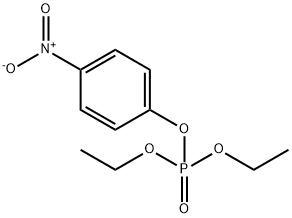Chemical Properties
Oily Liquid
Chemical Properties
Paraoxon is an odorless, reddish-yellow oil.
Fruity odor.
Uses
A cholinesterase inhibitor
Uses
Paraoxon-ethyl has been used as a substrate?in paraoxonase (PON) activity assay. It has also been used as a lipase inhibitor to study the effects of anacetrapib on homotypic transfer from high density lipoprotein?L3 (HDL3)?to?HDL2?
in vivo.
Definition
ChEBI: An aryl dialkyl phosphate where both the alkyl groups are ethyl and the aryl group is 4-nitrophenyl.
General Description
Reddish-yellow oily liquid with a faint fruity odor.
Reactivity Profile
Organophosphates are susceptible to formation of highly toxic and flammable phosphine gas in the presence of strong reducing agents such as hydrides. Partial oxidation by oxidizing agents may result in the release of toxic phosphorus oxides.
Fire Hazard
Flash point data for PARAOXON are not available; however, PARAOXON is probably combustible.
Biochem/physiol Actions
Potent irreversible acetylcholinesterase inhibitor
Safety Profile
A deadly poison by ingestion,intraperitoneal, intravenous, subcutaneous, intramuscular,and parenteral routes. Mutation data reported. Humansystemic effects: coma, convulsions, miosis. Acholinesterase inhibitor. An insecticide. When heated todecompos
Potential Exposure
An organophosphate insecticide. Has
been used as a medication.
Shipping
UN3018 Organophosphorus pesticides, liquid,
toxic, Hazard Class: 6.1; Labels: 6.1-Poisonous materials.
Incompatibilities
Keep away from alkaline materials and
strong oxidizers. Contact with oxidizers can cause the
release of toxic oxides of phosphorus. May react violently
with antimony(V) pentafluoride. Incompatible with lead
diacetate, magnesium, silver nitrate. In the presence of
strong reducing agents such as hydrides, organophosphates
form highly toxic and flammable phosphine gas.
Waste Disposal
In accordance with 40CFR165,
follow recommendations for the disposal of pesticides and
pesticide containers. Must be disposed properly by following
package label directions or by contacting your local or
federal environmental control agency, or by contacting
your regional EPA office.


